Oldendorff working with MIT to make ship design breakthroughs

Oldendorff Carriers is looking to tap some of the nuances of aerospace design to make breakthroughs in naval architecture.
The German shipping goliath has signed a research agreement with the Massachusetts Institute of Technology’s (MIT) Center for Bits and Atoms (CBA). Oldendorff, together with CBA and its campus collaborators including MIT’s Sea Grant Program, will investigate disruptive improvements in ship design and propulsion to achieve the IMO 2030/50 requirements.
The initial emphasis will be directed at improving hydrodynamic efficiency, which builds on work CBA has been doing with the aerospace and automotive industries. This looks beyond traditional naval architecture to a deeper integration of form and function. Anticipated research areas include morphing structures, hydrodynamic cloaking, moving boundary layers, and alternative energy sources.
CBA’s digital material technology is based on digitising not just designs but also the construction of materials, in the same way that all of life is based on twenty amino acids. The resulting structures promise to bring to shipping benefits including record-setting material properties, integrated heterogeneous functionality, automated lifecycle assembly and disassembly, and reduced environmental footprints.
Oldendorff CEO Peter Twiss commented, “We recognise that clean oceans and clean air are vital for our survival, both as a company and as individuals. With less than 10 years to implement a fundamental shift on how ships are powered in order to achieve the GHG reduction mandates, Oldendorff Carriers is partnering with MIT’s preeminent experts in technology research to forge the way ahead.”
MIT’s Center for Bits and Atoms is an interdisciplinary initiative exploring the boundary between computer science and physical science. It’s known for pioneering advances in digital fabrication, materials, robotics, computing, biology, and design. It manages a unique facility for rapid-prototyping across length scales, and has created a network of thousands of community fab labs.
